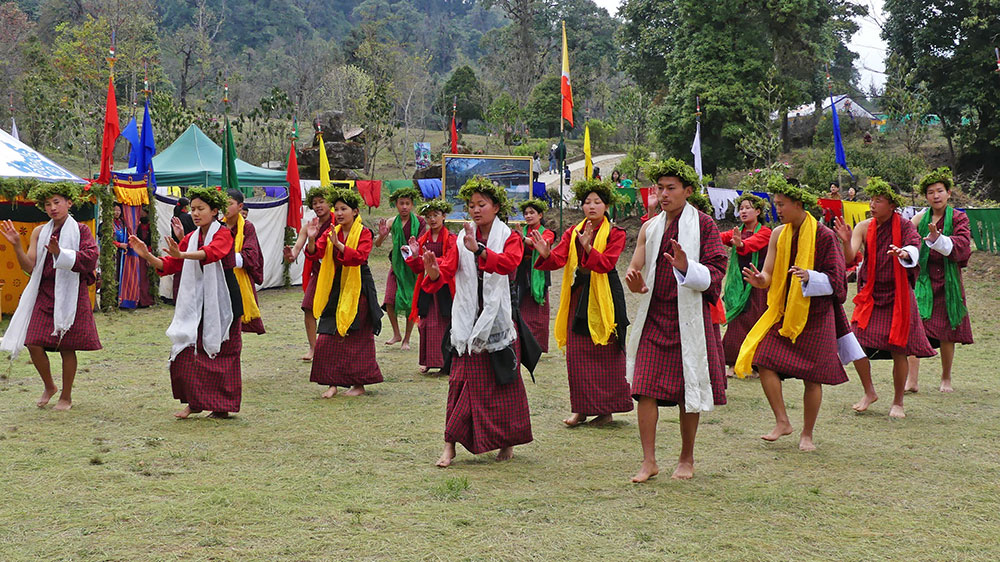Yangyel Lhaden
Descending Dochula this time of year, one is greeted by a different species of Rhododendrons in full bloom. Adorned with hues ranging from lush greens to vibrant pinks and fiery reds, as if blushing with delight, the expansive view stretches on.
Just a few kilometres away from this natural wonder, the annual Rhododendron Festival is happening at Lampelri recreational park.
Over 2,500 visitors have come to the park. Among them are approximately 1,000 international and regional tourists.
Among the 46 species of rhododendrons found in the country, the park is home to 29 species.
At the time of the festival, seven are in full bloom.
“The festival also celebrates the discovery of the 46th rhododendron species. Kesangiae, was named in honour of Her Majesty the Royal Grandmother, Gyalyum Kesang Choeden Wangchuck,” Park Manager Nima Tshering says.
While most other rhododendron species in the park bloom between February and mid-March, Kesangiae blooms in April, coinciding perfectly with the festival.
The festival setup is modest, featuring a handful of stalls offering local food, cocktails, and items, alongside traditional sports like khuru and archery.
Hosted annually by the Toedpisa Gewog Administration, the festival takes place in Lampelri. The gewog administration collaborates with two schools in the area: Dechentshemo Central School and Thinleygang Lower Secondary School (TLSS), alternating their involvement each year.
This year, TLSS is leading the charge. Students and teachers have been actively involved in hosting cultural shows and dances, running a food stall, and coordinating khuru and archery activities.

More than 2,000 international tourists and locals visited the rhododendron festival




The park is home to 29 species
For the Toedpisa Gewog, the festival holds significance beyond being a mere event; it serves as a vital opportunity for their community to generate income. The donations collected from visitors are divided between the gewog and the school, with a 70-30 split.
However, according to Toedpisa Gup Tshering Penjor, the festival was shortened to two days from three this year, and they received a decreased budget from the Department of Tourism (DoT).
The funds from the tourism department are used for various purposes such as event preparation, providing daily subsistence allowances (DSA) for staff, and offering refreshments during the festival.
Tshering Penjor says that the festival serves as a significant initiative for the country to generate revenue from tourism. It draws attention from international tourists, as the festival is often included in their travel itineraries by travel agencies.
Hosting such events, he says, fills the gewog with pride.
If the gewog had the autonomy to organise the entire event, with some initial funding support from the government, it could substantially enhance the festival, Tshering Penjor says.
Currently, the event depends on funding from the DoT, affecting the gewog’s organising capacity.
Says Nima Tshering: “We received the official letter confirming the festival’s dates only on April 8th this year. This short notice limited the time available for people to prepare local products, potentially explaining the lower participation levels observed during the festival.”
Karma Wangmo is operating a food stall with her family at the festival. The menu includes tongba, ara, changkoe, and local snacks.
“Because I had prepared changkoe and tongba last year, I could participate in the festival,” Karma Wangmo says.
At the festival ground, Thinley Phuntsho Dorje, an eighth-grade student, is overseeing the khuru game. In just three hours on the first day of the festival, he has managed to earn close to Nu 2,000. “This can be used to repair the ceiling of our multi-purpose hall, and perhaps even help make a football ground for the school.”
Bhumo, 80, walks over to Thinley’s stall and retrieves his own khuru set to join in the game. “It is so much fun. Living nearby, I wouldn’t miss it for the world.”
A tourist from the UK says of the festival with admiration: “We arrived on the 10th, there are 10 of us, and the festival is brimming with cultural performances and stunning rhododendrons!
“We would love to return in 10 years to commemorate our group of 10 and relive this wonderful experience.”


